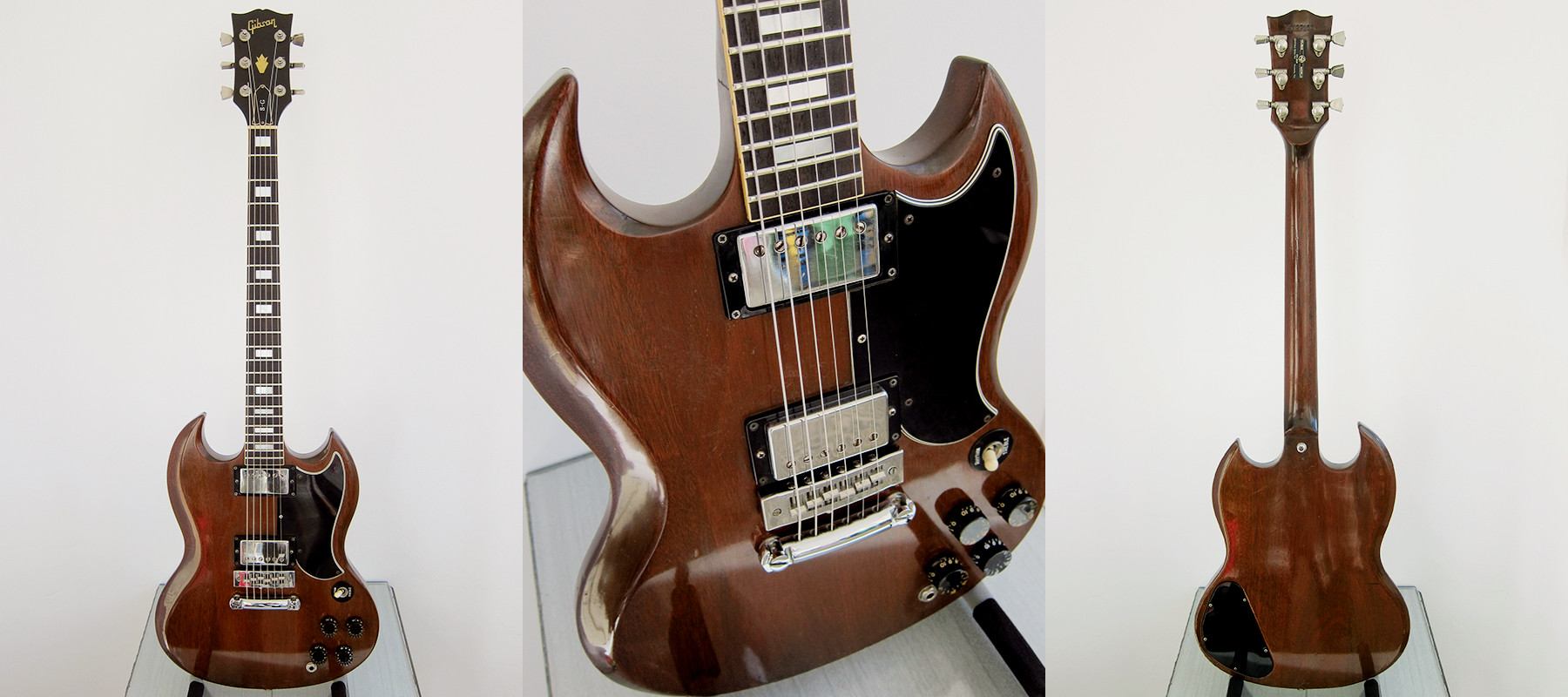Recently, I had the privilege of examining a classic 1977 Gibson Walnut SG Standard. The guitar belonged to a friend of a friend, and the task was to ensure it was in top playing condition for gigs. One of the first things I did was turn to the invaluable Guitar Dater Project to confirm its origins. According to The Guitar Dater Project, the serial number indicated it was indeed manufactured at the Kalamazoo Plant in the USA on December 15th, 1977, bearing the production number 103. This confirmed its vintage pedigree and added to the excitement of working on a piece of guitar history.
 Close-up of a 1977 Gibson Walnut SG Standard guitar in walnut finish, showcasing the body and hardware details, ideal for vintage guitar enthusiasts and Gibson SG lovers.
Close-up of a 1977 Gibson Walnut SG Standard guitar in walnut finish, showcasing the body and hardware details, ideal for vintage guitar enthusiasts and Gibson SG lovers.
 Close-up of a 1977 Gibson Walnut SG Standard guitar in walnut finish, showcasing the body and hardware details, ideal for vintage guitar enthusiasts and Gibson SG lovers.
Close-up of a 1977 Gibson Walnut SG Standard guitar in walnut finish, showcasing the body and hardware details, ideal for vintage guitar enthusiasts and Gibson SG lovers.
Verifying Vintage Guitar Authenticity with the Guitar Dater Project
The Guitar Dater Project is an essential online resource for anyone looking to authenticate and learn more about their guitars. Specifically for Gibson guitars, like this SG Standard, it allows you to input the serial number and receive information about the manufacturing location and date. This is crucial for vintage instruments as it helps verify originality and can significantly impact value. In this case, the project confirmed the guitar’s 1977 Kalamazoo origin, providing peace of mind about its age and place of manufacture. For enthusiasts and buyers alike, utilizing a guitar serial number decoder like the Guitar Dater Project is a vital step in understanding the history of an instrument.
Maintenance and Care for a 1977 Gibson SG
Beyond dating the guitar, the inspection revealed a well-preserved instrument needing only minor attention. Electrically, everything appeared original except for one potentiometer. Instead of replacing the original jack due to minor crackle, a thorough cleaning with wire wool and contact spray proved sufficient. This approach aimed to maintain the guitar’s vintage integrity. Additionally, tightening loose pots and screws across the machine heads, strap buttons, pickguard, pickup rings, and bridge, along with a gentle wood polish, brought the guitar back to optimal condition.
 Detail of the cleaned electronics of a 1977 Gibson SG Standard guitar, highlighting the original components and the meticulous maintenance performed to ensure optimal performance for gigging musicians.
Detail of the cleaned electronics of a 1977 Gibson SG Standard guitar, highlighting the original components and the meticulous maintenance performed to ensure optimal performance for gigging musicians.
A more noticeable issue was a cut in the edge binding at the 5th fret, affecting playability. This was carefully addressed by masking the area, filling it with color-matched wood filler, sanding it smooth, and applying nitro lacquer for a seamless repair. While photographic documentation of the final lacquer and sanding stages was missed, the repair effectively eliminated the playing impediment and preserved the neck’s smooth profile.
 Repair process of an edge binding cut on a vintage Gibson SG guitar neck, showing the wood filler application before sanding and lacquer, demonstrating guitar repair techniques for vintage instrument preservation.
Repair process of an edge binding cut on a vintage Gibson SG guitar neck, showing the wood filler application before sanding and lacquer, demonstrating guitar repair techniques for vintage instrument preservation.
Regarding cosmetic wear, the owner preferred to retain the body’s dents and scratches, appreciating the character they imparted as signs of age. However, neck dents were softened using a steam technique with a soldering iron and damp paper. This method, while not always completely effective, helps to raise compressed wood fibers, reducing dent depth. Finally, frets and fretboard were polished and treated with lemon oil, and new strings were installed. The action and intonation were already well-set, requiring no further adjustments.
 Close-up of the body of a 1977 Gibson SG Standard guitar showing natural wear and tear, embraced as a sign of age and character by vintage guitar collectors and players.
Close-up of the body of a 1977 Gibson SG Standard guitar showing natural wear and tear, embraced as a sign of age and character by vintage guitar collectors and players.
Conclusion: Vintage Gibson SG Ready to Rock
In conclusion, working on this 1977 Gibson SG Standard was a rewarding experience. The Guitar Dater Project quickly and efficiently confirmed its vintage authenticity, while careful maintenance addressed minor issues without compromising its originality. This vintage SG is now ready to deliver decades of rock and roll for its owner, a testament to the enduring quality of guitars from this era. For anyone interested in vintage guitars, tools like the Guitar Dater Project are invaluable for uncovering the story behind each instrument.
